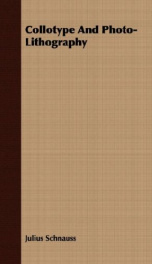collotype and photo lithography

I. Introductory CONTENTS. - II. Bichromates in Conjunction with Organic Substances - III. Summary of the more important Printing Processes with Chromated Gelatine - IV. Collotype Apparatus - V. Chemicals and Materials for Collotype VI. Preparation of the Collotype Plate VII. Negatives suitable for Collotype VIII. Printing in the Press - IX. Finishing and Varnishing Collotype Prints X. Other Collotype Processes - XI. Failures in Collotype In the Preparation of the Plates - XII. Investigations on Collotype XIII. Collotype XIV. Magic Prints in Natural Colours - XV. Photo Glass Printing - XVI. Allgeyers Collotype Process XVII. Practice of Photo- Lithography XVIII. Autography XIX. Negatives for Photo-Lithography - XX. Application of the Carbon Process to Photo- Lithography - ... APPENDIX. PAGE. 9 12 18 25 46 59 72 88 96 102 I0 7 114 II 9 122 I2 4 127 I 3 35 149 tearn Presses - 162 TRANSLATORS PREFACE. THE impossibility .of obtaining any work in the English language on the subject of Collotype first led to my translation of the German work of Dr. Schnauss, and the fact that no work has hitherto appeared fully dealing with the matter is the excuse I offer for the present publication. The translation is necessarily one of considerable freedom, but it is offered as containing all the information to be found in the original, and in addition, considerable extensions, made with the authors consent. The omission of the chapter dealing at length with the steam machine was necessitated by the fact that the rotary machine there described is no longer manufactured. Without pointing to the frontispiece in any sense as a high-class work, it may serve to show that I have made some practical acquaintance with the subject. The illustration, printed on ordinary paper, was produced from the instructions found in this work, and I may add that at the time of writing I have printed over 500 impressions from the first plate, and it still remains in fair working condition. STANMORE ROAD, BIRMINGHAM. EDWIN C. MIDDLETON. COLLOTYPE AND PHOTO-LITHOGRAPHY. CHAPTER I. INTRODUCTORY. THE observation by Mungo Ponton of the sensitiveness to light of bichromate of potassium in conjunction with organic substances is but little more recent than the discovery of photography itself. if sized paper is saturated with an aqueous solution of this salt and then exposed under any transparent design, the latter will be reproduced as a negative of a brown colour on a yellow ground. If the exposed paper is placed in water, the bichromate salt will be removed from the unexposed, and consequently un- altered portions the image will remain brown after this treatment, though somewhat bleached. The sensitiveness to light is proportionately in- creased by the addition of larger quantities of organic substances, as starch, paste, glue, sugar or gum, as first observed by Becquerel. This arises in consequence of the organic matter being oxidised by the chromic acid, a corresponding decomposition and reduction of the chromate salt to chromate of chromium taking place. In the year 1853 an Englishman Fox-Talbot, the gifted discoverer of calotype i.e., the production of photographic negatives on paper by means of B
Info about the book
Author:
Series:
Unknown
ASIN:
B004QOABXM
Rating:
5/5 (4)Your rating:
0/5
Languge:
English
Users who have this book
Users who want this book
What readers are saying
What do you think? Write your own comment on this book!
write a commentif you like collotype and photo lithography try:
Other books by this author
Do you want to read a book that interests you? It’s EASY!
Create an account and send a request for reading to other users on the Webpage of the book!

